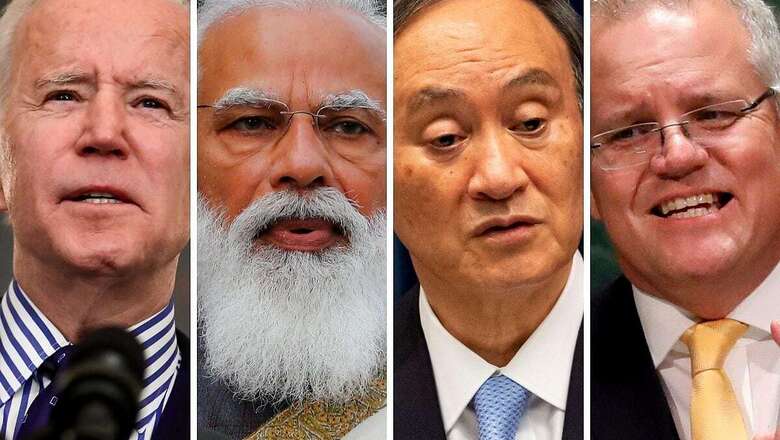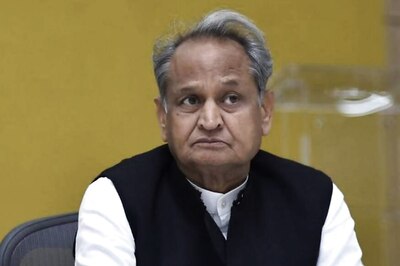
views
The Chinese Foreign Minister Wang Yi in 2018 had dismissed the Quadrilateral Framework (Quad for short) as “sea foam” that would dissipate! By October 2020, he began to see the contours of an “Indo-Pacific NATO” instead, reflective of a “Cold War mentality” meant to “stir up confrontation”. Nevertheless, Beijing was counting on President Joe Biden to go slow, if not reverse the momentum that former President Donald Trump had imparted to the Quad dialogue.
How could the veteran diplomat have known that it was soon to become the cornerstone of America’s Indo-Pacific policy and that too within two months into the Biden Presidency. It was a double whammy for China—the 3rd Quad foreign ministers’ meeting convened by Secretary of State Antony Blinken on February 18, followed by the landmark first-ever Quad Summit on March 12 at the behest of President Biden. The import was not lost on anyone, least of all on China, which was quick to revert to homilies!
The spokesperson of Chinese foreign office hoped that the Quad nations will be mindful of “the common interests of the regional countries, uphold the principles of openness, inclusiveness and … do things that are conducive to regional peace stability and prosperity rather than the opposite.” Hats off to the Middle Kingdom for its brazen hypocrisy!
On the other hand, the Quad leaders were measured yet upfront in characterizing the first-ever, leader-level summit as a “historic occasion”; recognizing the “global devastation wrought by COVID-19, the threat of climate change, and security challenges facing the region” and pledging to jointly strive “for a region that is free, open, inclusive, healthy, anchored by democratic values, and unconstrained by coercion”.
Putting all doubts to rest, the leaders spoke unequivocally and in one voice. India which was reluctant until recently to even use the moniker ‘Quad’ gladly signed up for the first-ever joint statement. What a journey it has been! From a near-death in 2008, to a tentative revival in 2017, elevation of dialogue to foreign ministers’ level in September 2019 and a (virtual) summit on the trot now. Rarely in history have events of such far-reaching geostrategic significance unfolded at such brisk pace.
How did this come about? The candid answer is—China. But for its aggression, extraterritorial ambition and complete disdain for established norms, conventions and international law, it is difficult to see how Quad could have come this far and with such urgency. Beijing committed the blunder of opening too many fronts by taking on most of its neighbours, including tiny Bhutan. But even more so, it challenged the American supremacy, forcing the giant to bestir itself.
Unlike Europe, the Asian continent lacks a security structure. Traditionally, the US has been the security provider. Washington also has security agreements with countries such as Japan and South Korea. All the same, consequent to 9/11 and the financial crisis of 2008, the US lost its polar position economically, although it still remains the most formidable military power at least for the time being.
While the Obama Presidency was marked by equivocation, the successor regime of Donald Trump presented an inward-looking America that hiked the price tag on security for its friends and allies. President Biden has signalled that “America is back” and would lead by example. He seems to be walking the talk (thus far).
More or less subscribing to Trump’s approach, the experienced Biden team has designated China as the strongest competitor (not adversary) which is trying to upstage the US. All the same, the White House is “ready to work with Beijing when it’s in America’s interest to do so”. US Secretary of State and National Security Adviser Jake Sullivan are scheduled to meet CCP Politburo member Yang Jiechi, and Foreign Minister Wang Yi in Anchorage, Alaska, on March 18-19.
Both sides appear to be sizing each other up. It remains to be seen if Beijing under pressure would make a tactical yet tempting offer to Washington. And secondly, whether the latter will bite or continue taking a strategic long-term view. If it hopefully adopts the latter course, there would be reason to believe that Quad has come of age.
The Quad summit was not only a powerful statement of intent but also substantive in outcome. It took the prevalent pandemic head-on and agreed to pool financial resources and manufacturing capabilities to produce 1 billion doses of Covid-19 vaccine by the end of 2022. It recognizes India’s capabilities “as a reliable manufacturer of high-quality vaccine,” said the Indian Foreign Secretary. It depicts that Quad framework is capable of and willing to deal with crises, whether natural or man-made. Salient points emerging from the summit include:
1. Quad commits to promoting a free, open rules-based order, rooted in international law to advance security and prosperity and counter threats to both in the Indo-Pacific and beyond.
2. Quad will work together and with a range of partners.
3. The sides will cooperate on the critical technologies of the future.
4. Quad emphasizes the urgent need to restore democracy and giving priority to strengthening democratic resilience.
5. Quad foreign ministers will converse often and meet at least once a year.
6. An in-person Quad summit will be held by the end of 2021.
The Quad summit heralds the beginning of a new great game. Will rule of law be restored in the Indo-Pacific region and beyond or ‘rule of power’ will be the new paradigm? Stay tuned, the game has just begun.
Read all the Latest News, Breaking News and Coronavirus News here




















Comments
0 comment